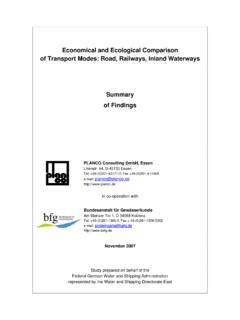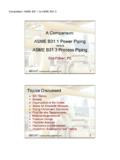Transcription of ANALYSIS AND REPORT WRITING TIPS - …
1 OMG Center for Collaborative Learning ANALYSIS AND REPORT WRITING tips Most Important Things to Remember About Data ANALYSIS 1. Develop a plan before you analyze data. Specify how good is good enough. Specify what you will do with each kind of data, including when you will combine categories and how you will present results (as numbers, %s or categories). Figure out how you will handle missing data. 2. Develop some dummy tables or lists to hold your analyzed data share those with others. 3. Identify the most important findings from your data, summarize them and then use the specific results ( , a table or list of data) to clarify your findings. 4. Present your ANALYSIS in an orderly, meaningful, simple way. Things to Avoid When Analyzing Data 1. Including response rates and problems with your methodology as part of your findings.
2 2. Reporting both numbers and percents unless one is needed to make the other clear. 3. Listing in a sentence or a table, all of the response choices for every question on a survey in the order they appear on the survey. [Don t do this with interview data either] 4. REPORT your results with excessive precision most of the time you can just round to the nearest whole number when reporting percentages. 5. Feel compelled to keep your results in the same order as they appeared on the survey or the interview protocol. It is the job of the analyst to order things in the best way to clarify the findings you are NOT REQUIRED to present things in the order you asked them. 6. Do not include any action steps or conclusions that are not clearly developed from your findings.
3 OMG Center for Collaborative Learning Most Important Things to Remember About REPORT WRITING 1. Follow the REPORT WRITING outline in your manual. Feel free to be somewhat flexible with the order, but don t leave out whole sections. 2. Make your own internal outline including who is responsible for which sections. Be sure that you leave time for stakeholders to help you with editing/making revisions. 3. Be economical in your decisions about what to include in your REPORT . Shorter is better. 4. Avoid excessive use of jargon. 5. Read your work if you can t understand it, chances are others won t be able to either. Think, in simple terms, about what you are trying to say, and then write that. Use complete sentences and standard English grammar conventions.
4 You can rely some on bullets and be limited in your transitions, but be sure your reader can follow your logic. 6. Formatting is your friend. Use headers and sections to help your reader know what is happening in your REPORT . Be consistent about where and how they appear (centered, bold, underlined, side headings etc.). NUMBER THE PAGES. IF YOU RE GENERATING A DRAFT THINK ABOUT DOUBLE-SPACING. 7. Use tables and Graphs to help illustrate findings. ALL TABLES AND GRAPHS MUST HAVE TITLES, LABELS AND LEGENDS OR FOOTNOTES SO THAT THEY STAND ALONE. 8. Use quotes and vignettes or snippets from field notes to illustrate your findings. Remember quotes should have quote marks around them and be attributed to the speaker or writer. If you are presenting field notes, be sure they are clearly identified and in context.
5 9. Be consistent in your use of language, capitalization, punctuation etc. For the most part, evaluation reports should be written in the past tense only REPORT what you actually did and what you found. The action steps or Issues for Further Consideration sections can include references to future actions. 10. Do not introduce totally new topics into your REPORT in the final sections. Do not use the REPORT to explain why you changed your design, what you didn t do, and what should be happening with a program regardless of the findings presented in the REPORT . OMG Center for Collaborative Learning SUGGESTED EVALUATION REPORT OUTLINE I. Introduction A. Introduction to agency and/or program (mission, goals, and main activities) B. Purpose of evaluation C.
6 Evaluation Questions 1. Clear and concise questions that are in alignment with program mission and goals. 2. If there are several evaluation questions, group them into categories ( , service delivery, staff outcomes, participant outcomes, programmatic impacts). D. REPORT Organizer (optional and un-necessary if REPORT is short) II. Methods/Data Collection Strategies A. Description of selected methods (in narrative or table form) B this describes what actually happened during data collection, not what the evaluator set out to or attempted to do. *B. Relationship between questions and data collection strategies (usually done as a table) *C. Data collection rationale B explanation of why methods were chosen including clarification regarding use of participatory data collection.
7 *D. Data collection respondents and missing data B description of the target populations for each data collection activity including why they were selected and whether there is any missing data. *E. Data collection challenges *F. Description of targets for ANALYSIS (this can also be addressed in the findings section). ** Note Sections b - f, can all be addressed as part of the description of selected methods. III. Evaluation Findings A. Summaries of the results of data collection and ANALYSIS B. Response to evaluation questions (where feasible) C. Comparison of findings to targets (where feasible and appropriate) V. Conclusions A. Summary of Key Findings B. Final ANALYSIS * How does the author understand the data * How does the author believe the data will impact the program * Strengths and weaknesses of the program as revealed by evaluation findings.
8 C. Action Steps/Recommendations B what will be done with the REPORT , what could/or should be done with the program D. Issues for Further Consideration (any outstanding issues raised by the evaluation)







